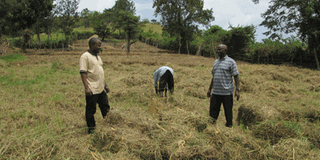Growing pastures becoming good business, investment for farmers

Tumusiime, a farmer who grows pastures, explains shows how hay is collected from the field. PHOTO BY OTUSHABIRE TIBYANGYE
What you need to know:
- Supplementary feeding gives better milk yields It is, therefore, important that alternative methods of feeding are promoted.
- the ultimate goal is to identify and nurture ideas and innovations around agribusiness value chains, technical and business training, networking, funding opportunities, marketing support and mentorship
- Seed production has already started taking shape in Kiruhura District, under Kazo Dryland Husbandry Agro Pastoralists Association (Kadhapa)
Pasture seed farmers in south western region of the country are set to benefit from investment in seed pastures and better animal nutrition for their dairy animals.
This is through initiatives by an incubation public-private partnership known as Curad—Consortium for Enhancing University Responsiveness to Agribusiness Development.
Curad is looking at commercialising innovations that have been developed around pasture seed and systems to ensure the availability of quality pasture seeds for improved productivity of livestock under intensive smallholder farmers and ranch systems in the country.
Apollo Ssegawa, the Curad managing director, says the ultimate goal is to identify and nurture ideas and innovations around agribusiness value chains, technical and business training, networking, funding opportunities, marketing support and mentorship.
“Seed production has already started taking shape in Kiruhura District, under Kazo Dryland Husbandry Agro Pastoralists Association (Kadhapa), which started seed production in 2013 with three acres of Rhodes grass (Chrolis Gayana) and 0.75 acres of legumes”, he says.
According to the Kadhapa chairman Erison Tumusiime, in the first harvest, a total of 600kg for Chrolis Gayana and 150 kg of legumes was realised respectively. This earned Shs4.5m at Shs25,000 per kilogramme, which proves the venture to be lucrative.
Although the natural environment in Uganda provides good grazing for cattle, sheep and goats, with indigenous breeds dominating most livestock, this is not likely to continue with the increasing population pressure on the land, which includes the grazing areas.
Besides, supplementary feeding gives better milk yields It is, therefore, important that alternative methods of feeding are promoted.
And one of the prerequisites, for this to happen is that there must be a steady supply of pasture seeds to the farmer.
About 95 per cent of all livestock in the country is raised by smallholder farmers according to the World Bank-sponsored 2010 National Livestock Productivity Improvement Report (NLPIP) .
“This makes the improvement of output by the small holder farmer a key priority and the innovations and seed systems developed at NARO and Makerere provides a perfect opportunity to help improve the output of these farmers by using improved pastures in the feeding systems,” Ssegawa asserts.
Production of pasture seeds provide a compelling business opportunity that will help in government’s poverty eradication programmes as indicated in the PMA, PEAP and Vision 2040.
Kelen Munyerere, a member of Kadhapa from Rwamanuuma village in Kazo Town Council, who has 2.5 acres of Rhodes grass attests to this.
Since she started the project in 2015, she has been able to earn extra income from growing pasture seed.
“I have been able to harvest 15 bags of seeds approximately 300 kg per season and earned about Shs4m and also sold bales of hay to individual farmers at Shs5,000 per bale after harvesting the seeds,” she says.
“Besides that, I harvest twice in a year thus enabling me to earn more money”,
She also benefits from the hay residue, which she uses for mulching her banana plantation.
Munyerere is also happy about the fact that being in a group has minimised the role of middlemen as they do bulk sales.
“We sell our produce especially the pasture seeds through Kadhapa where we get a uniform price and bulk sale so that we are able to get the money at once”, she says.
Against this background, Ssegawa says Cuard will work with individual farmers and farmer groups. The target is about 200 farmers from the region.
“We have identified two lead farmers and we shall use their farms as model farms for others to learn the skills from especially those that are beginning the business,” he says.
Tumusiime, one of the lead farmer, says the demand for seed pastures and hay is not only high in Uganda but also in neighbouring countries such as South Sudan where he exported last season.
However, he calls for training of farmers not to focus on selling their produce only but also on feeding their animals.
“Before focusing on exporting the hay and other products, we should learn to feed our animals. The results will be tremendous,” he says.
Training
Ssegawa says the Curad training will begin with about 100 farmers in October. It is to acquaint them with the skills that they need for pasture growing and feeding their animals.
“We intend to pattern with AGDI Farm in Kyakabunga village for training services so that farmers are to have hands on training.”
Col. Dick Bugingo, the managing director, AGDI farm, says there is an AGDI training facility, which was set up with support from The Netherlands embassy. It will act as an incubation centre.
The centre was built in March this year to promote dairy farming.
“The main objectives at the centre are giving practical skills in the dairy sector, knowledge about breeding, feeding, cow health and management of a farm”, he says.
Since it opened in July, a total of 50 farmers have trained in a number of skills.
One of the beneficiaries of the trainings, Fred Mugisha, a 70-year-old dairy farmer, says the skill he learnt which has fascinated him is bucket feeding.
“I have been able to see bucket feeding and I am ready to implement it at my farm because it has many advantages especially on reducing mastitis and improving calves fast growth as the get the right quantity of milk,” he says.
Others skills learnt are supplementary feeding using maize bran, silage, growing of pastures, artificial insemination and animal health.
Value addition
Ssegawa says after the farmers harvest the pastures, Curad will support them in cleaning the seeds, bulk sales, branding and packaging.
“We are putting up a bulking centre for value addition located in Kabanyoro where Makerere University’s agricultural institute is.”
Challenges
Pasture farmers are faced with the challenge of labour especially when harvesting the seeds.
This has to be done manually. The harvesting and processing of hay is laborious, so there is need for machines and tractors for opening up the land as well as the need for storage facilities after harvesting.
For more about dairy farming, register for Daily Monitor/Seeds of Gold Farm Clinic on October 1.




